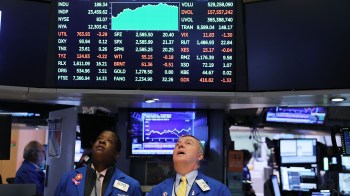
Inflation and politics have always been connected
Inflation and politics have always been connected

The word “inflation” is everywhere today, and it continues to shape how people feel about the economy. That’s the case despite the pace of inflation retreating from its high of June 2022, when prices were up nearly 9% from the year before, as measured by the consumer price index. Last month, prices were up only 3.4% on an annual basis.
While it’s easy to think those feelings are unique, inflation has long been a top concern for Americans, going back to the founding of the country. One key thing that’s changed is how the government has intervened in the movement of prices.
For example, during World War II, the Franklin D. Roosevelt administration implemented price controls. “Price controls really involved a massive state effort because you had to have surveillance to make sure they were being complied with,” said Carola Binder, associate professor of economics at Haverford College. “Shop owners would have an incentive to try to sell things at market rate rather than the control rate. So you had basically housewives who are volunteering to go around and make sure that everyone was complying.”
In her book, “Shock Values: Prices and Inflation in American Democracy,” Binder looks back at the long history of politics, inflation and how the government has tried to respond, at times through fiscal policy like price controls, at others with monetary policy. The following is an excerpt from her book, explaining why she decided to write it.

In 2021, inflation in the United States exceeded 5 percent for the first time in decades. From there, it continued to climb. Like most economists, I carefully tracked this ascent, eagerly poring through the inflation reports that came out each month. I earned a PhD in economics in 2015; for my entire career, policy makers and scholars had been concerned about inflation that was too low rather than too high; almost overnight, the situation had dramatically reversed.
The United States had not experienced such high inflation since the Great Inflation of the 1970s and early 1980s. Back then, neither President Richard Nixon’s price and wage controls nor President Gerald Ford’s notorious red “Whip Inflation Now” buttons stopped wages and prices from spiraling upward. The Great Inflation ended only when Federal Reserve chairman Paul Volcker finally committed to, and followed through with, a program of severe monetary tightening. This so-called Volcker disinflation was a painful process involving a long recession, high interest rates, and high unemployment. But it demonstrated the power of monetary policy for stabilizing prices and pointed to a solution to the problem of recurrent inflation: delegate price stability to the central bank, and give the central bank independence in the pursuit of this goal.
Following the Volcker disinflation, the practice of raising interest rates in the face of inflation became consensus among academic economists around the world. And the academic consensus became the political reality. Central banks were granted substantial political independence to facilitate their pursuit of price stability. Many central banks announced explicit numerical targets for inflation in the 1990s and 2000s. In the United States, the Federal Reserve kept inflation low and relatively stable for years, but it waited until 2012 to explicitly announce its own 2 percent inflation target. Its preferred measure of inflation, the annual change in the Personal Consumption Expenditures (PCE) price index, averaged 2.1 percent from 1985 to 2020.
The return of inflation in 2021, in a time after central bank economists had seemingly solved the riddle of price control and produced decades of price stability, shook the economics profession hard. But the return of inflation was not only, or even primarily, an academic concern. It was, even more, a social and a political one. The impacts of inflation are widespread, and its causes are difficult to understand. Rising prices affect every member of society and can be especially devastating to families struggling to afford groceries, gas, and other necessities. Unsurprisingly, people suffering the ill effects of inflation are loath to leave it in the hands of central bankers — they want their elected officials to do something to slow the pace of price increases, preferably without Volcker-style rate hikes and rising unemployment.
But what can be done? In January 2022, the Washington Post asked a dozen economists for ideas to combat inflation. One of them, Todd Tucker of the Roosevelt Institute, proposed using price controls. “The time is now,” he wrote, “to begin destigmatizing greater democratic control over price levels.” Tucker’s characterization of price controls as “democratic” echoed the logic of his think tank’s namesake, President Franklin Delano Roosevelt, whose administration implemented an extensive system of price controls and rationing during World War II. This system, Roosevelt argued, was “the only Democratic, equitable solution” for the war-time economy, as “those who can afford to pay more for a commodity should not be privileged over those who cannot.” Pamphlets of Roosevelt’s Office of Price Administration proclaimed, “Of the People, by the People, for the People, Price Control.”
Tucker was not alone in calling for price controls. For example, in the Guardian, the economist Isabella Weber compared the inflation situation of 2021 to World War II, suggesting that “the government could target the specific prices that drive inflation instead of moving to austerity which risks a recession.” Price controls, which had seemed relegated to history after the Volcker disinflation, were back on the table.
It is worth emphasizing the difference between price controls and the current approach of allowing the Federal Reserve to “control” prices. The Fed’s 2 percent inflation target is a target for aggregate inflation — the rate of change of an official measure of the overall price level. The Fed does not target the prices of specific goods or services. Thus, the relative prices of different products can vary freely depending on supply and demand conditions. Price controls, in contrast, impose restrictions on particular prices and prevent relative prices from fluctuating freely. They thus disrupt the powerful informational and coordinating role of prices in a market economy. The effects of such disruption, of course, depend heavily on circumstances.
As I am writing this book, it seems unlikely that anything resembling the World War II price controls will become a serious policy contender in the United States. But that doesn’t mean that the calls for price controls can be ignored. They are a symptom of deep discontent with our economic and political system and its approach to price stabilization. High inflation in 2021 and 2022 did not, by itself, cause this discontent, but it did make it more apparent. Public trust in the Federal Reserve began to decline, and calls for other forms of state intervention in prices abounded. Because I am an economist who studies inflation, central banking, and economic history, I have followed these developments closely as they unfolded. And I have become convinced that understanding our current inflation environment requires much more than just economic analysis. As a society, our approach to inflation and price stabilization is closely tied to our approach to democracy. And both of these approaches have changed over time.
I wrote this book to provide an account of how price fluctuations and attempts to manage them — through price controls, monetary policy, tariff policy, and other means— have shaped American democracy since its very beginning. By price fluctuations, I mean movements in both aggregate and particular prices. For much of US history, especially before aggregate inflation statistics were readily available, certain prices, like land prices, crop prices, and energy prices, have been especially consequential. The book proceeds chronologically from the colonial era to the present, tracing the evolution of beliefs about price fluctuations and the role of the state in American democracy. It is not just an economic or monetary history but also a history of thought, synthesizing views from legal scholars and the courts, economists, political scientists, politicians, and the popular press. I do provide policy recommendations in the last chapter, but more than I hope to convince anyone of my recommendations, I hope to equip readers with and without formal economics training to think more deeply about what alternative approaches to price stabilization might mean, not just for the economy but for the social and political system.
Reprinted with permission from “Shock Values” by Carola Binder, published by the University of Chicago Press. © 2024 by the University of Chicago. All rights reserved.
There’s a lot happening in the world. Through it all, Marketplace is here for you.
You rely on Marketplace to break down the world’s events and tell you how it affects you in a fact-based, approachable way. We rely on your financial support to keep making that possible.
Your donation today powers the independent journalism that you rely on. For just $5/month, you can help sustain Marketplace so we can keep reporting on the things that matter to you.


















